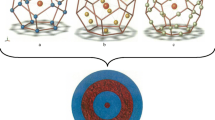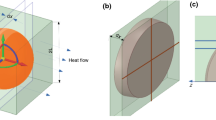Abstract
Model for overall thermal pressure coefficient (TPC) of a composite reinforced with layered particles is developed. It is based on the incremental homogenization scheme that replaces layered inclusions by homogeneous ones producing the same effect. Various laws of property variation across the interphase are discussed. It is shown that the most important parameters controlling effective TPC are the relative thickness of the interphase layer and the mean value of TPC across this layer.
Similar content being viewed by others
References
Chen T.Y., Dvorak G.J., Yu C.C. (2007) Solids containing spherical nano-inclusions with interphase stresses: effective properties and thermal mechanical connections. International Journal of Solids and Structures, 44, 941–955
Duan H.L., Karihaloo B.L. (2007) Thermo-elastic properties of heterogeneous materials with imperfect interphases: Generalized Levin’s formula and Hill’s connections. Journal of the Mechanics and Physics of Solids, 55, 1036–1052
Dunn M.L (1993) Exact relations between the thermoelectroelastic moduli of heterogeneous materials. Proceedings of the Roya l Society of London, A441, 549–557
Hashin Z, Shtrikman S. (1963) A variational approach to the theory of the elastic behavior of multiphase materials. Journal of the Mechanics and Physics of Solids, 11, 127–140
Hill R. (1963) Elastic properties of reinforced solids: Some theoretical principles. Journal of the Mechanics and Physics of Solids, 11, 357–372
Levin V.M. (1967) On the coefficients of thermal expansion of heterogeneous material. Mechanics of Solids, 2, 58–61
Markov K.Z. (2001), Justifcation of an effective field method in elasto-statics of heterogeneous solids. Journal of the Mechanics and Physics of Solids, 49, 2621–2634
Mütschele T., Kirchheim R. (1987) Hydrogen as a probe for the average thickness of a grain boundary. Scripta Metallurgica, 21, 1101–1104
Papazoglou E., Simha R., Maurer F.H.J. (1989) Thermal Expansivity of Particulate Composites: Interlayer versus Molecular Model. Rheologica Acta, 28: 302 – 308
Ponte-Castaneda P., Willis J.R. (1995) The effect of spatial distribution on the effective behavior of composite materials and cracked media. Journal of the Mechanics and Physics of Solids, 43 (12): 1919–1951
Rosen B.W., Hashin Z. (1970) Effective thermal expansion coefficients and specific heats of composite materials, Inernationa. Journal of Engineering Scences, 8, 157–173
Sevostianov I., Kachanov M. (2007) Nanoparticle reinforced materials: effect of interphase layers on the overall properties. International Journal of Solids and Structures 44, 1304–1315
Sevostianov I., Kachanov M. (2006) Homogenization of a nanoparticle with graded interphase. International Journal of Fracture 139, 121–127
Shen L, Li J. (2003) Effective elastic moduli of composites reinforced by particle or fiber with an inhomogeneous interphase. International Journal of Solids and Structures, 40, 1393–1409
Author information
Authors and Affiliations
Corresponding author
Rights and permissions
About this article
Cite this article
Sevostianov, I. Dependence of the Effective Thermal Pressure Coefficient of a Particulate Composite on Particles Size. Int J Fract 145, 333–340 (2007). https://doi.org/10.1007/s10704-007-9132-z
Published:
Issue Date:
DOI: https://doi.org/10.1007/s10704-007-9132-z




